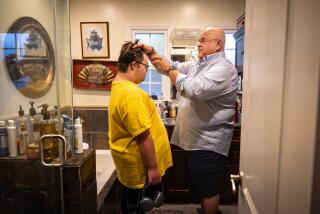State’s stem cell agency seeks more time, money
When millionaire Silicon Valley real estate developer Bob Klein launched his ballot drive to create a $3-billion state fund for stem-cell research in 2004, he pitched it as a way of taking politics out of science and focusing on cures. One particularly heartbreaking campaign ad showed former big screen Superman Christopher Reeve paralyzed in a wheelchair, struggling for breath and imploring California voters to “stand up for those who can’t.”
Next month, Klein’s six-year term as chairman of the California Institute for Regenerative Medicine expires. Under his stewardship, the agency has funded research leading to hundreds of scientific papers, but scientists say marketable therapies for maladies such as cancer, Alzheimer’s and spinal cord damage promised during the campaign remain years, if not decades, away.
In a recent interview with The Times, Klein said he plans to ask voters to approve another $3 billion in a bond measure on the 2014 ballot to keep the stem cell program going.
The agency was approved by many voters as a rebuke to President George W. Bush’s ban on federal funding for embryonic stem cell research. The cells are at an early stage of development in which they retain the ability to morph into cells of almost any body part. Researchers hope they can be used to regenerate damaged organs, including spinal nerves. Bush imposed the ban because the process of obtaining the stem cells involves destroying human embryos. Supporters of the research accused the Bush administration of allowing politics to trump science.
But California’s stem cell agency quickly found itself mired in another form of politics: legislators and government watchdogs criticized the program for paying its president more than twice the governor’s salary, distributing nearly $1 billion to universities with representatives on its board of directors and overselling the promise of stem cell cures.
“Unfortunately, the campaign fell into sound bites and most people voted for it with the expectation that there were going to be stem cell cures in a year, that Superman would walk again,” said John Simpson of the Santa Monica based Consumer Watchdog.
Moreover, with the Obama administration having restored federal support for stem cell research, a separate state program may no longer attract as much voter support.
Klein, a 65-year-old entrepreneur who was inspired to find money for stem cell research after his son was diagnosed with juvenile diabetes, shrugs off the criticism and political doubts, confident that there will be “plenty of evidence” to present to voters by the time they are asked to approve more money.
“I passionately believe there will be some remarkable new therapies that will save lives and mitigate suffering substantially,” Klein said during an interview in the gleaming new stem cell research building at his alma mater, Stanford University, which was partially funded by a $43-million grant from the stem cell program.
Of the roughly $1.1 billion committed from the agency’s budget so far, Stanford has received more than any other institution, just under $176 million, according to the agency’s website. UCLA is second with $135 million, and UC San Francisco is third with $111 million. All three schools have direct representation on the agency’s board; the deans of their medical schools are voting members.
In all, $930 million has gone to institutions with faculty or administrators on the board.
Klein and his colleagues say the money went to train graduate students in stem cell research techniques and attract well-known professors to California’s most prestigious universities, an obvious first step toward making the state a leader in the emerging technologies. Another big chunk of the money, roughly $270 million, went to the construction of new labs — built without federal funds so research can’t be cut off if a new administration in Washington once again turns off federal support for work using stem cells.
“These buildings represent academic and nonprofit safe harbors where that research can be protected and proceed despite radical changes in Washington,” Klein said.
Last year, the Little Hoover Commission, a state panel devoted to accountability and transparency, suggested reducing the number of seats on the 29-member board, in part, so the tremendous amount of money going to board members’ institutions wouldn’t look so awkward. “Criticism that CIRM’s governing board remains an insider’s club undermines the legitimacy of the agency,” the commission’s June 2009 report stated.
Other critics have gone further. “When you’re talking about spending $1.1 billion dollars, there’s absolutely no excuse for people making the decision to give themselves the money,” said Robert Fellmeth, executive director of the Center for Public Interest Law at the University of San Diego.
While board members recuse themselves from voting on grants where they have a direct conflict, the mere presence of so many conflicted members is a concern, Fellmeth said. “There is a quid pro quo atmosphere that develops, because you defer to each other.”
Another sore point has been the high salaries paid to top administrators, who handle a staff of about 50. In 2009, President Alan Trounson, a renowned stem cell scientist from Australia, was paid $490,000, the second highest salary in state government outside the university system, records show.
By comparison, the governor’s salary, which Arnold Schwarzenegger declines, is $173,987, and the governor is responsible for oversight of more than 200,000 state employees.
In the research realm, Francis S. Collins, director of the federal government’s National Institutes of Health which employs more than 17,000 people and invests $32.5 billion in medical research each year, makes $199,700, said spokesman Don Ralbovsky. Collins is one of the nation’s best known genetics researchers.
Nevertheless, Klein argues his organization’s president must be well-paid in order to attract the strongest candidates. “If you’re going to fund research at the highest level of excellence, you have to make certain that the scientific leadership you have in the organization is on a comparable scale,” Klein said.
Former state Democratic Party chairman and ex-state Sen. Art Torres, who was hired as vice-chairman of the board in 2009 to help fight off some of the political criticisms leveled at the agency, also makes more than the governor: $225,000 per year.
Torres’ hiring raised eyebrows among critics because his salary was “over the magic number of $200,000, which sets off whistles in Sacramento,” said Don Gibbons, the agency’s communications director, who earns $190,000 per year.
It’s not just outsiders who have criticized high salaries in the stem cell program. “I haven’t been comfortable with the amount that we pay, it is more than most people in state government,” said Jeff Sheehy, a San Francisco AIDS activist who is a patient advocate on the board.
But Sheehy defended Torres’ hiring, saying the ex-senator’s political skills have addressed a glaring weakness. “We had a very hostile, almost adversarial relationship with the Legislature, now it’s much better.”
Klein did not take any salary from the agency for the first four years of its existence, but said he recently had to start drawing $150,000 per year, a fraction of the $529,000 allowable for his position as board chairman, according to the agency’s pay scale. “In the midst of a major recession that has not been kind to real estate, it became necessary to at least take some salary,” he said.
But the agency’s most daunting political challenge may be the agonizing pace of medical research.
Gary Steinberg, a Stanford neurosurgeon working with a $20-million grant from the stem cell program, understands the dilemma well.
In his lab, Steinberg said he has been able to induce strokes in mice then cure them of the symptoms by injecting stem cells into their brains. The cells migrate of their own volition to the damaged area and become precisely the type of tissue needed to repair the injury, Steinberg said.
His grant will cover four years researching the treatment in mice to make sure the treatment doesn’t cause dangerous side effects, like tumors. The next step would require years of clinical trials on small numbers of human patients to see if the treatment works safely for them. Even if all goes well, a proven therapy doctors could prescribe for their patients could still be a decade away, Steinberg said.
The program “is under a lot of pressure to demonstrate some wins, “ Steinberg said, “and so far we haven’t changed anything, we haven’t moved anything to the clinic.”
More to Read
Get the L.A. Times Politics newsletter
Deeply reported insights into legislation, politics and policy from Sacramento, Washington and beyond. In your inbox three times per week.
You may occasionally receive promotional content from the Los Angeles Times.











